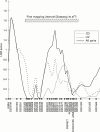Fine mapping of the chromosome 3p susceptibility locus in inflammatory bowel disease
- PMID: 11156639
- PMCID: PMC1728207
- DOI: 10.1136/gut.48.2.191
Fine mapping of the chromosome 3p susceptibility locus in inflammatory bowel disease
Abstract
Background and aims: Genetic predisposition for inflammatory bowel disease (IBD) has been demonstrated by epidemiological and genetic linkage studies. Genetic linkage of IBD to chromosome 3 has been observed previously. A high density analysis of chromosome 3p was performed to confirm prior linkages and elucidate potential genetic associations.
Methods: Forty three microsatellite markers on chromosome 3 were genotyped in 353 affected sibling pairs of North European Caucasian extraction (average marker density 2 cM in the linkage interval). Marker order was defined by genetic and radiation hybrid techniques.
Results: The maximum single point logarithm of odds (LOD) score was observed for Crohn's disease at D3S3591. Peak multipoint LOD scores of 1.65 and 1.40 for the IBD phenotype were observed near D3S1304 (distal 3p) and near D3S1283 in the linkage region previously reported. Crohn's disease contributed predominantly to the linkage. The transmission disequilibrium test showed significant evidence of association (p=0.009) between allele 4 of D3S1076 and the IBD phenotype (51 transmitted v 28 non-transmitted). Two known polymorphisms in the CCR2 and CCR5 genes were analysed, neither of which showed significant association with IBD. Additional haplotype associations were observed in the vicinity of D3S1076.
Conclusions: This study provides confirmatory linkage evidence for an IBD susceptibility locus on chromosome 3p and suggests that CCR2 and CCR5 are unlikely to be major susceptibility loci for IBD. The association findings in this region warrant further investigation.
Figures


Comment in
-
Chromosome 3p and inflammatory bowel disease.Gut. 2001 Sep;49(3):455. doi: 10.1136/gut.49.3.455. Gut. 2001. PMID: 11550665 Free PMC article. No abstract available.
References
Publication types
MeSH terms
Substances
LinkOut - more resources
Full Text Sources
